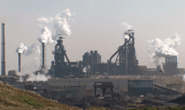Steel Mills

U.S. Steel Industry to Reap Rewards from a Price on Carbon: CRU Study
Written by Michael Cowden
May 27, 2021
The U.S. steel industry stands to benefit in a big way should the government put a price on carbon emissions, according to a study by CRU, Steel Market Update’s parent company.
CRU examined the potential impact of a standard fee on carbon emissions and an equivalent border carbon adjustment (BCA) and found that such policies could reduce imports by as much as 50% and increase steel industry profitability by approximately 30-40% depending on product mix.
![]() The reason: “Steel producers in the U.S. … have some of the lowest CO2 emissions intensities anywhere in the world,” CRU said in the report.
The reason: “Steel producers in the U.S. … have some of the lowest CO2 emissions intensities anywhere in the world,” CRU said in the report.
The CRU study was commissioned by the Climate Leadership Council, a bi-partisan non-profit focused on carbon policy.
The Big Idea
The U.S. would impose an economy-wide fee of $43 per tonne on CO2 emissions. It would in tandem implement a BCA of the same amount on CO2 emissions associated with manufactured products imported into the U.S.
U.S. steelmakers would benefit from such a framework because they emit approximately half as much CO2 as competitors abroad when it comes to flat products. And domestic producers emit only about a quarter of the CO2 as mills abroad when it comes to long products, the CRU study said.
“This significant carbon advantage reflects the high share of scrap-based electric arc furnaces (EAF) – which are less emissions-intensive than blast furnace-based manufacture,” the study noted.
The U.S. steel industry is unique in that as much as 70% of its output comes from the EAF route as opposed to the integrated route, which typically has higher emissions because of the carbon-intensive coking process.
“Lower relative costs of domestic steel manufacture reduce steel imports from both developed economies (such as Canada and Japan) as well as major emerging markets such as China, Mexico and Brazil,” the study said.
EAF flat-rolled steel producers stand to benefit the most from a BCA because they compete primarily against imported material made by integrated mills abroad, CRU said.
But while EAF mills might gain the most, the overall benefits of a carbon fee and related border adjustment would be widespread. Mills in the Great Lakes region – where installed capacity is primarily integrated – could see domestic sales of flat products increase by 2.6 million tonnes per year. And mills on the West Coast could also become “newly competitive” with a BCA in place, the study said.
As for the cost to steel consumers, the impact of a carbon fee and BCA is forecast to be significantly less than that of Section 232 tariffs. “The impacts on final consumers are likely to be limited, in part, by the modest share of steel compared to total production costs or final product prices,” CRU said.
But the U.S. steel industry only retains its carbon edge if it continues to stay ahead of competitors abroad when it comes to reducing emissions. And a BCA could provide incentive for foreign steelmakers to “heavily decarbonize” in order to maintain or regain access to the U.S. market.
“These longer-term trends may limit the uplift in U.S. domestic value-add, but will nonetheless create potential benefits for global decarbonization efforts,” the study said.
Industry Reaction
Lobbying groups for domestic steelmakers welcomed the conclusions of the CRU study.
“One key finding of the study is that the domestic steel industry has a major carbon advantage over the rest of the world,” Steel Manufacturers Association (SMA) President Philip K. Bell said. “It is time to update climate and trade rules in ways that give American steelmakers credit for their environmental stewardship.”
The American Iron and Steel Institute (AISI) sounded a similar note. “The study makes the case that a strong and effective border carbon adjustment must be part of any effective U.S. climate policy,” AISI President and CEO Kevin Dempsey said. “The U.S. government should be promoting the increased use of cleaner American steel and taking steps to ensure that U.S. climate policies don’t result in an increase in foreign steel imports that have much higher carbon intensities.”
The SMA primarily represents EAF producers and the AISI mostly integrated producers.
By Michael Cowden, Michael@SteelMarketUpdate.com

Michael Cowden
Read more from Michael CowdenLatest in Steel Mills

Nucor names Batterbee, Bledsoe to HR roles
Nucor Corp. has promoted Thomas J. Batterbee to the position EVP of human resources and talent and appointed Elizabeth Bledsoe to the newly created position of president of human resources and talent.

Millett sees tariffs, CORE case benefiting SDI
Steel Dynamics' top exec thinks Trump’s tariff policies, as well as the results from the recent CORE case, will prove advantageous to the Fort Wayne, Ind.-based steelmaker and aluminum company.

USW digs in on opposition to USS-Nippon deal
“We remain deeply concerned about the national and economic security implications of the subject transaction,” the union stated in the letter dated April 21.

SDI’s Q1 earnings slump on-year, but up sequentially
SDI earnings slip in first quarter year over year, but are up sequentially.

POSCO inks MoU with Hyundai on Louisiana EAF mill
POSCO has signed a Memorandum of Understanding (MoU) with Hyundai Motor Group that includes an equity investment in Hyundai’s previously announced EAF mill set to be built in Louisiana.
